原文网址:http://www.sixthtone.com/news/1002917/turning-camels-into-cash-cows
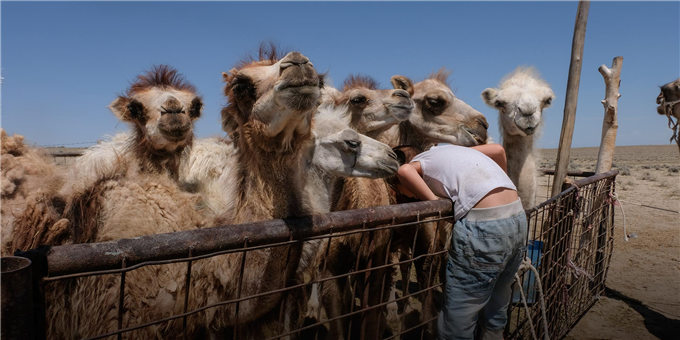
XINJIANG, Northwest China — The road to Fuhai County looks like something out of a classic Western film. Barren hills stretch across the horizon where muddy grassland meets a blue sky splashed with streaks of cloud. You’d almost expect to see rolling tumbleweed or gunslingers on horseback — until a pair of stone camels disrupt the illusion.
The life-size two-humped camel statues mark the county boundary and are soon superseded by thousands of living ones grazing across China’s camel heartland. For centuries, the milk — with its peculiar salty aftertaste and faint animal aroma — has been used by ethnic Kazakhs, who make up half the county’s population, to treat common ailments like coughs and colds. Now, one man has turned the camels into cash cows, building his empire in this sleepy backwater.
Play Video
Aykush Kaken is one of nearly 10,000 people in Xinjiang’s Fuhai County who has turned to camels for more money and a better quality of life. By Lu Yunwen/Sixth Tone
Since 63-year-old veteran businessman Chen Gangliang set up Xinjiang Wangyuan Camel Milk Co. Ltd. in 2007, it’s become one of the most successful camel milk enterprises in the world. It started as a cooperative that collected and processed milk from a handful of local herders. These days, Wangyuan receives up to 20 tons of milk every day from 5,000 families who together own over 100,000 camels.
“It’s something magical,” 63-year-old Chen says of camel milk, as he sits on a throne-like chair at his expansive office building in Fuhai Town, the county’s downtown area. A photo of herders competing in a 2013 camel race hangs on the wall behind him, and several camel statuettes decorate his office shelves. In a low-pitched voice that sometimes fades into the loud buzz of the air conditioner, Chen describes the milk’s many health benefits, glancing occasionally at the dozen-or-so cans and bottles displayed across his desk. Like any good salesperson, Chen leans on personal anecdotes to make his case more convincing.
“I drink camel milk for breakfast,” says Chen, smiling to reveal teeth stained from smoking two to three packs of cigarettes a day. “I’m in better spirits, and I’m sick less often.”
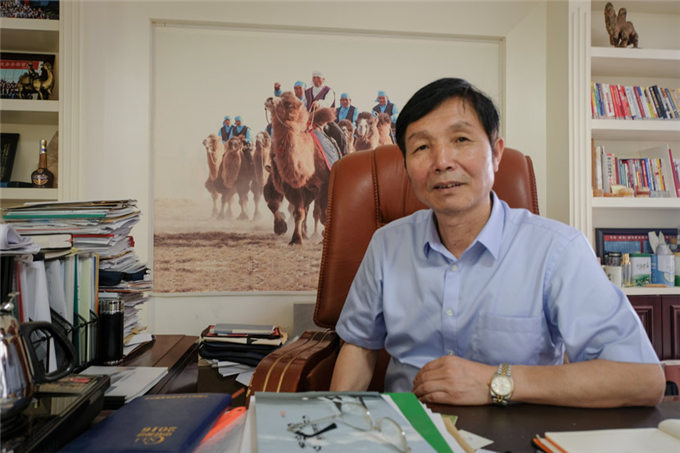
Chen Gangliang poses for a photo in his office at the headquarters of Xinjiang Wangyuan Camel Milk Co. Ltd. in Fuhai County, Xinjiang Uyghur Autonomous Region, July 8, 2018. Bibek Bhandari/Sixth Tone
Chen has grand ambitions for his company and his so-called magic potion: He wants it to become a certified medical product for diabetes and other immunity-enhancing products, meaning it could be used in the public health sector. The businessman — and camel milk proponents around the world — claim the drink is a superfood that can help people with tuberculosis, diabetes, and autism, as well as cure allergies and Crohn’s disease. Chen says the company is now investing more time and money into research and development so they can produce drugs using camel milk.
But it’s not all rosy for Chen and his camel milk empire. There’s still a lack of regulation in the industry and hard evidence to back up the medical claims — both of which could hinder the company’s ability to reach out to a bigger market. These issues weigh heavily on Chen, who feels personally responsible for the futures of the thousands of herders who work for him.
Chen was in his late 40s when he saw his first camel. He often travelled to Dubai in the early 2000s for his then-flourishing textile business. There he became fascinated by the single-humped Arabian camels, just as visitors to China are captivated by giant pandas.
As he traveled more in the region — Iran, Jordan, and Saudi Arabia, where camel milk is widely consumed and sold — Chen saw business opportunities, too. When the businessman returned to China in 2006, he headed to the camel heartlands of the Inner Mongolia, Ningxia, Gansu, and Xinjiang.
In Fuhai — a two-hour drive, six-hour flight, and a three-hour train ride away from his hometown on the other side of the country in coastal Zhejiang province — Chen met locals who had been raising the region’s native two-humped Bactrian camels for generations. Chen’s textile business was already worth hundreds of millions of yuan, but he was eager for a new challenge — and for the huge potential cash flow from a relatively untapped industry.

A GIF shows a camel grazing in Fuhai County, Xinjiang Uyghur Autonomous Region, July 9, 2018. Lu Yunwen/Sixth Tone
“People here were so simple and honest and had all these resources, yet they were still poor,” Chen says, reflecting on how he felt when he first came to Xinjiang in 2006. He still recalls how he met one family who was so excited about his promise of setting up a camel milk business that they walked behind his car for 30 minutes to see him off. “It was so touching — I felt [setting up the camel milk business] turned into a responsibility toward the community.”
In 2010, when Wangyuan’s products first hit the shelves, its revenue was almost zero, according to marketing manager Liu Shanshan. Since then, sales revenues have been increasing rapidly: In recent years, revenue has grown at 30 percent annually, and last year it reached 180 million yuan ($26.5 million). By 2020, the company estimates it will reach 900 million yuan a year. Most sales are in big cities like Beijing, Shanghai, Guangzhou, and Shenzhen, where residents have relatively high incomes and are more receptive of healthy lifestyle trends, according to Chen. A 2018 industry report found Wangyuan to be among eight key players in the global camel milk industry that are all enjoying a “staggering growth rate.”

In a way, Wangyuan got lucky: In the past decade, camel milk has emerged as a health fad, not just in China, but also in the Middle East, United States, United Kingdom, and Australia. The United Nations’ Food and Agriculture Organization (FAO) called it “the next thing” as early as 2006 because of the milk’s rich vitamin content and the opportunities it offered for people in low-income regions. A 2013 report by the FAO stated that Bactrian camel milk is good for children with allergies, and pointed to research saying that camel milk can cure tuberculosis and improve liver function in hepatitis patients.
Across the globe, camel milk is being touted as a superfood, and health-conscious consumers in China and overseas alike are prepared to pay a steep price for camel milk’s benefits, which include higher levels of protein, calcium, and Vitamin C than those found in cow milk. Among the apparent advocates is reality star Kim Kardashian West, who captioned a 2012 Instagram post of a glass of milk: “Got Camels Milk???”
Nevertheless, Chen’s not concerned that camel milk could be a flash in the pan — after all, people have been drinking it for centuries.
In Fuhai, camel milk is part of daily life. In the morning, it’s poured into a big ceramic bowl and used to make tea which tastes like the butter tea found in the Tibet and Nepal. On summer evenings, when the sun sets after 10 p.m., shops selling camel milk yogurt — which tastes only faintly different from cow milk yogurt — stay open till almost midnight.
Before Wangyuan’s arrival in the county, herders mainly kept camel milk for personal consumption — there were few ways to make money from it. Most spent their days herding sheep and cattle, or farming. Nowadays, Fuhai’s long highways are dotted with big billboards promoting Wangyuan’s camel milk, which portray how the drink of the formerly low-income herders has helped them become the nouveau riche.
Aykush Kaken is one of the thousands of Fuhai natives who switched professions to take advantage of the camel milk gold rush. Coming from an ethnic Kazakh family, camels have been a part of his life since he was young; his family lived a nomadic life, and used the animals for transportation, clothing and, occasionally, for milk. “When I was about 5, we moved from one place to another, sometimes as far as 500 kilometers,” 37-year-old Aykush Kaken says, recalling his childhood. “My father rode on a horse with me, leading the camels.”


In the past, Aykush Kaken’s father, Kaken Nurasi, was a village vet and supplemented his income by selling camel milk. (Kazakh herders take their father’s first name as their last name). After Wangyuan was founded, the 68-year-old Kaken Nurasi began selling camel milk to the company — he claims to be among the first to do so. His life has since become more settled: These days, he moves the camels to graze on the grasslands in the summer, and returns to a permanent, cozy home with stables big enough to house the animals during the winter.
Initially, many young people like Aykush Kaken didn’t want to become herders. After graduating from middle school, he traded cattle and goats, earning a monthly salary of 4,000 yuan. Noticing that his father was earning thousands of yuan by herding camels for their milk, Aykush Kaken switched professions. In 2015, he bought 17 camels for about 15,000 yuan each under a Wangyuan scheme that provided interest-free loans for herders to buy camels. He now has 90 of them, and sells all milk to Wangyuan, making up to 300,000 yuan a year.
“Many people my age raise camels now,” Aykush Kaken says on a sweltering 37-degrees-Celsius afternoon in July, puffing through one cigarette after another inside his yurt, where he lives during the summer months. White and dome-shaped from the outside, inside it’s decorated with a riot of colorful patterns and complete with solar-powered appliances and kitchenware.
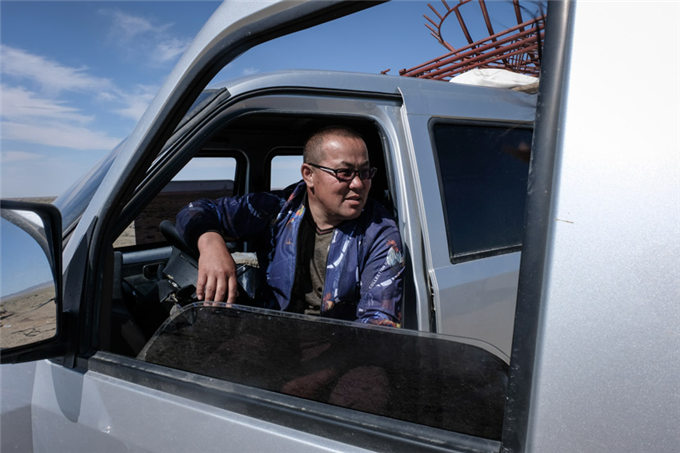
Aykush Kaken poses for a photo in Fuhai County, Xinjiang Uyghur Autonomous Region, July 9, 2018. Bibek Bhandari/Sixth Tone
Despite the heat and the sweat trickling down his knuckles, Aykush Kaken keeps his light jacket on. With his tucked shirt, black-rimmed glasses, and articulate tone, the 37-year-old has an aura of an executive — only his tanned skin and rosy cheeks reveal that he spends most of his time outdoors. While he handles the business side of things, his wife and an assistant milk the camels three times a day.
In the early afternoon, the 20-year-old hire Adallik Nudek whiles away the hours playing on his phone and blowing cigarette smoke into the blue sky, ignoring the punishing sun and the powerful wind. When the clock strikes 2 p.m., he leaps on a Wuyang Honda motorcycle and zooms off to herd the camels for the afternoon milking session. He brings the animals over to an enclosed area close to the yurts where the calves are briefly allowed to suckle on their mothers to get the milk flowing. Then, the adult camels are attached to pumps, and the milk flows into steel containers. Each camel takes just over five minutes to milk, and in about two hours, Nudek and Aykush Kaken’s wife Gana Guli Kahan milk 20 camels.
At 8 a.m. the following morning, when there’s no wind and the temperature is a comfortable 25 degrees Celsius, the local herders appear one after another in a dusty patch overlooking the grasslands, some on Honda motorbikes, some in trucks. By the time Aykush Kaken pulls up with the previous day’s batch of milk in tow, Wangyuan’s collection truck is already parked under the imposing shadow of a government billboard. As the company representative tests samples of the milk for contamination, the women and men chat, smoke, and linger — a kind of camel herders’ motorcycle club.
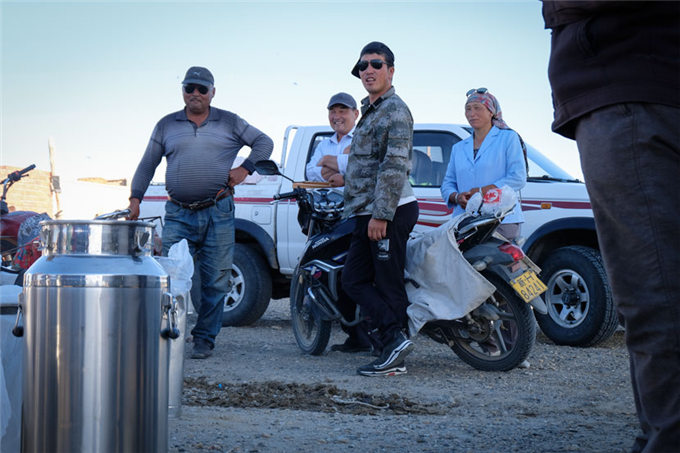
Herders stand around while delivering their milk at Wangyuan’s collection point in Fuhai County, Xinjiang Uyghur Autonomous Region, July 10, 2018. Bibek Bhandari/Sixth Tone
When asked about how the camel milk business has improved their lives, the herders’ answers are almost uniform: better houses, bigger cars, less work pressure, and increased income.
“Life is much better now,” says 37-year-old Aman Muhamat, who inherited the business from his grandfather and father in 2011. He only owns 20 camels, but says the family still reaps the rewards from them. “I have bought a car, built a house, and now earn more than 100,000 yuan a year.”
“My son is a government official, so I do this with my wife,” says another herder, 56-year-old Amandari Mustapa. “We have 50 camels and earn more than [we did] before … more than our son.”
Today, the average income for herders and farmers who grow crops in Fuhai is about 14,000 yuan a year, a threefold increase from less than 5,000 yuan a decade ago. Those involved in the camel milk supply chain make more than others, and may have helped raise the county’s average income. In 2013, the prefecture government recognized Wangyuan as a model company for poverty relief, and last year the State Council awarded Chen with a national prize for relieving poverty.
At Wangyuan’s shop in Shanghai’s Jing’an district, visitors looking for alternative healing are welcomed into the store by a stuffed, two-humped camel toy. The shop is one of 1,300 Wangyuan outlets across the country where the company’s products — including camel milk powder and tablets — are displayed alongside their food certifications and patents. The walls are decorated with photos of Xinjiang’s green grasslands and blue sky, a stark contrast with the smoggy, muggy July evening in Shanghai.
Here, camel milk goes for 200 yuan per liter — about 20 times the price of cow milk. That’s partly because it’s in short supply. In 2016, Xinjiang alone produced 50,000 tons of camel milk — the most of any region or province in China — although it was still only around 3 percent of the region’s total cow milk production.
The high price also has to do with camel milk’s nutritional value, Wangyuan’s chief Shanghai distributor He Qingqing explains at the Jing’an branch.

A GIF shows Wangyuan’s production line. Courtesy of Wangyuan Camel Milk Co. Ltd.
To concerned parents like Chen Meijuan, Wangyuan’s goods offer hope — and healing properties. For almost two years, Chen Meijuan, who practices traditional Chinese medicine, has been feeding camel milk to her lactose intolerant three-and-a-half-year-old twins. Unlike with cow milk, which has slightly higher lactose content than camel milk, they’ve had no allergic reactions. Each month, the family consumes six tins of camel milk worth about 3,600 yuan total. “[The cost] is worth it for my children’s health,” Chen Meijuan says. Other parents have left glowing testimonies on the company’s website, too.
Doctors back in Fuhai make similar claims. On a brightly lit July evening, there’s only a smattering of patients at Fuhai Renmin Hospital, the county’s biggest medical center. Amur Buik Ashar, a general practitioner with four decades of experience, claims camel milk contributes to treatments for chronic gastroenteritis, diabetes, tuberculosis, and anemia. He often recommends camel milk as a health supplement, drawing on the teachings from his traditional Kazakh medical books that he keeps at his house. “There is something mystical in it,” he says.
Wangyuan, unsurprisingly, is invested in studying its medicinal benefits. He Qingqing, the distributor from the Shanghai store, claims that after her grandfather was diagnosed with lung cancer, camel milk helped him live more than a year longer than what the doctors predicted. In 2016, Wangyuan donated 3 million yuan to Xinjiang University’s camel industry engineering center. Yang Jie, a biochemistry professor at the university, says her research shows that extracts from camel milk can inhibit growth of more than a dozen types of tumor cells and boost immunity. Yang is filing for a patent for her research, which was selected by the local government this year as one of the region’s key research and development projects.

A researcher tests the pH level of a sample of camel milk in a lab at Xinjiang Wangyuan Camel Milk Co. Ltd. in Fuhai County, Xinjiang Uyghur Autonomous Region, July 8, 2018. Bibek Bhandari/Sixth Tone
But when Sixth Tone contacted three medical experts about Ashar or Wangyuan’s claims, all of them declined to comment, citing a lack of conclusive research.
Despite the lack of hard evidence, Wangyuan continues to promote the supposed therapeutic value of camel milk. Positive consumer reviews on the company’s website rave about its apparent benefits: One article claims that a patient with acute leukemia recovered dramatically after six months of eating camel milk tablets and drinking brewed milk powder. When Sixth Tone asked Wangyuan’s Chen about why the company posts glowing consumer anecdotes on its website despite the lack of scientific evidence, he said the company was only listing positive testimonies — not claiming that the products cure diseases.
There’s good reason for that: China’s commercial law has a blanket ban on companies promoting the therapeutic values of food items. In January, an online advertising company in Zhejiang hired by Wangyuan was fined nearly 600,000 yuan for false advertising after it claimed its camel milk has “obvious curative effects on tuberculosis, diabetes, cancer, and AIDS.” China’s cabinet described it as a “classic false advertising” case. Another camel milk company, Yili Xue Lian, markets its camel milk to cancer patients using the catchphrase “white gold.”
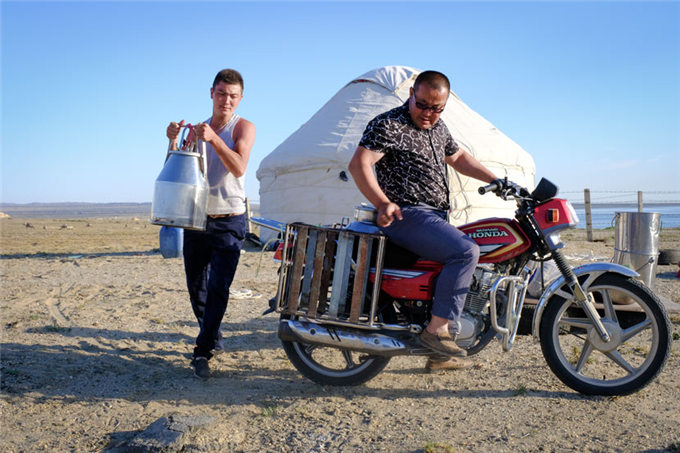
Aykush Kaken’s wife, Gana Guli Kahan, rests after her morning chores outside their yurt in Fuhai County, Xinjiang Uyghur Autonomous Region, July 10, 2018. Bibek Bhandari/Sixth Tone
There’s another problem facing camel milk: a lack of regulations. Despite tight controls over the milk industry as a whole following the 2008 tainted milk scandal, non-cow milk is still largely unregulated. The policy loopholes and loose law enforcement has resulted in copycat products flooding the market, which often deceive customers, says Liu Huaibin, Wangyuan’s distributor in Guangdong province. “Many [retailers] would brand other, cheaper milk powders as camel milk imported from Saudi Arabia and sell them in the market,” he says.
Lei Yongjun, a dairy industry expert and chairman of the Beijing-based consulting firm Proper Tao, tells Sixth Tone that many companies in China producing dairy from other animals than cows “bend the rules and brand themselves as health care products,” as the industry is still largely unregulated.
When asked if that has affected his company, Chen says copycat products haven’t influenced their sales yet — after all, Wangyuan is one of the most recognized camel milk brands in the country. But he says if the issue isn’t addressed soon, substandard products which don’t have the same health effects could give camel milk a bad name and impact business. That is why he’s pushing for a national standard on camel milk, which will allow companies to export their milk.
Ultimately, Chen believes it will be the medical certification that drives the future of his company and his army of camel milk suppliers. Four years ago, Chen applied for a health care product license for tablets made from the camel milk. He’s confident it will materialize within a year. “At last, we’ll be making this [milk] a biopharmaceutical product,” Chen says, his confident tone suggesting he believes it’s only a matter of time.
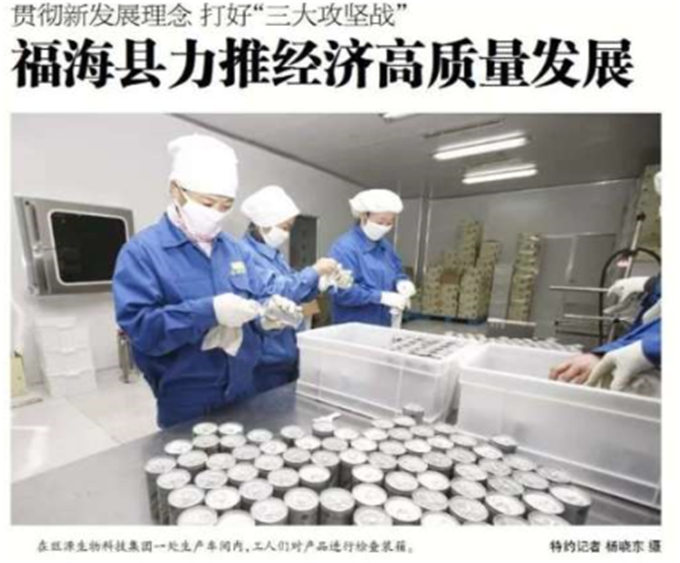
Adallik Nudek helps to load milk on Aykush Kaken’s motorcycle in Fuhai County, Xinjiang Uyghur Autonomous Region, July 10, 2018. Bibek Bhandari/Sixth Tone
It’s the promise of commercial success that has seen many herders change their career trajectories and shift to the camel business. Their futures have hinged on the milk’s apparent healing powers. For herders like Muhamat, the milk has worked like magic: He now has a higher income and can afford to splurge on things that were once mere dreams.
Nevertheless, he hopes for a different, camel-free future for his children. “I hope they go to school and find a decent job,” Muhamat says. “If that doesn't work out, they can come back and herd camels.”
Editor: Julia Hollingsworth.
(Header image: A boy plays with his family’s camels in Fuhai County, Xinjiang Uyghur Autonomous Region, July 9, 2018. Bibek Bhandari/Sixth Tone)